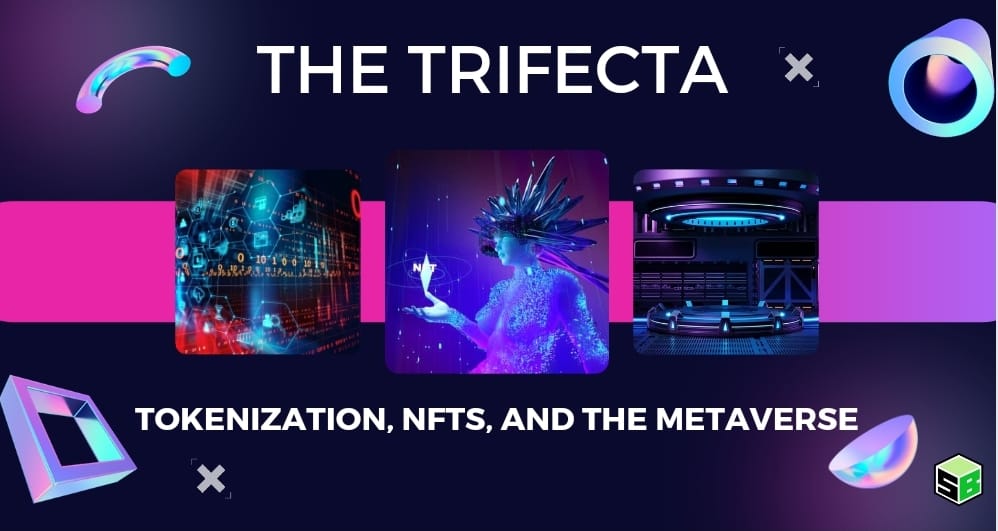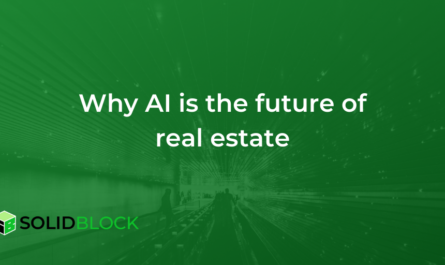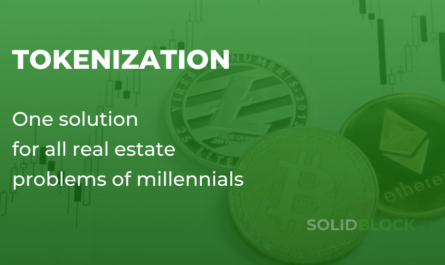
If you’re looking to make a splash in the blockchain space, we recommend you mention that winning trifecta: tokenization, NFTs, and the metaverse!
What do each of these terms mean? How are they interrelated? What are the trends in 2022? And how is SolidBlock using them to flesh out the promise of democratizing real estate investing?
Tokenization
Tokenization is a new way to securitize assets. To securitize an asset means to divide it into shares that you can sell to investors. In the same way, to “tokenize” an asset is to divide it into shares, or “tokens,” that represent a predefined portion of the underlying asset. They are therefore often called “security tokens.”
These tokens are secured through the immutability of blockchain technology, and they’re tradeable via crypto exchanges or Alternative Trading Systems (ATS), with each token holding a relative monetary value.
Any type of asset can be tokenized: land, housing, data. SolidBlock is a leader in tokenized real estate, creating compliant, secure digital securities that our investors can trade like stocks. SolidBlock’s tokenized real estate is backed by a real world asset.
NFTs
Non-fungible tokens (NFTs) are a type of digital asset or token that are not fungible, meaning they cannot be traded on a one-to-one monetary value because each unit has unique qualities that add or subtract to its value.
While they can be bought and sold, they cannot be copied. This allows for the creation and true ownership of scarce digital assets.
NFTs are like digital collectibles. Think of a baseball card collection where some cards—based on the player depicted, the condition, and the age of the card—are more valuable than others. Or of the art world, where owning a Picasso means the holder of this rare and rarified artwork is the rightful owner of the underlying asset as well.
Now, even Picasso is entering the digital age. Because NFTs can be linked to real world assets, in June 2021, Sotheby’s initiated a sale of an NFT of a digitized “twin” of a Picasso painting.
There are many use cases for NFTs, including providing authenticity of products and intellectual property, supply chain authentication, academic credentials, and even ticketing of events.
As the NFT hype continues to spread, there are reports of millions of dollars being spent on the equivalent of the digital pet rock, the drawing series of “Bored Apes,” and more fanciful—or outlandish—virtual art.
The Metaverse
Which brings us to the metaverse.
The global metaverse market size reached $47.69 billion in 2020 and is expected to register a revenue CAGR (compound annual growth rate) of 43.3% during the forecast period, reaching a calculated $828.95 billion in 2028.
That’s no small potatoes. But what does it mean? What will happen to produce such sizable increases in revenue?
Think of the metaverse as a possible extension of the internet. It uses the internet, virtual reality (VR), augmented reality, and other tech to create shared digital spaces, content, and experiences. It can be accessed from your computer, or your phone, or your VR goggles. It will always be on, and it will happen in Real-Time.
The metaverse is an active concept that has been hovering in the brains of the tech world for more than two decades. Imagine a collective virtual shared space that connects all virtual worlds together to create an endless playground where we can conduct our daily business. Perhaps it will be similar to the movies and games we immerse ourselves in. In the future, we may have a whole new identity and a life apart from our daily, grinding reality. We can visit museums, dance at a concert, travel to distant lands by ourselves or with a tour guide, or engage in our favorite activity all without leaving the comfort of our own home.
The precursors to the metaverse are active, engaging, and popular. There is Second Life, the largest user-created 3D universe, launched in 2003. Perhaps you were young enough to enjoy Club Penguin, a seamlessly crafted massive multiplayer online world for children that existed from 2005 to 2017. Minecraft, Fortnite, and even Animal Crossing invite players to participate with an avatar to socialize, build, battle, and buy-and-sell in an internal marketplace.
There are also platforms that are real estate oriented like Decentraland and The Sandbox. This September, DeFi Land raised $4.1M to launch a decentralized finance project that turns investment activities in a rural, agricultural setting into games. A plot of virtual real estate just sold for $4.3 million in The Sandbox, making it the most expensive metaverse property sale as of December 8, 2021.
Two distinct developments are fueling the creation of the metaverse: the advance of technologies that allow us to enrich our online experiences, like AI and blockchain; and the fallout from the worldwide COVID epidemic, which pushed us to socialize online.
Trends in 2022
Here’s one prediction from Bill Gates: “Within the next two or three years, I predict most virtual meetings will move from 2D camera image grids—which I call the Hollywood Squares model, although I know that probably dates me—to the metaverse, a 3D space with digital avatars. Both Facebook and Microsoft recently unveiled their visions for this, which gave most people their first view of what it will look like. The idea is that you will eventually use your avatar to meet with people in a virtual space that replicates the feeling of being in an actual room with them.”
And how will your avatar be dressed? Clothing and other swag for your avatar are becoming big business. These accessories are being sold as NFTs within the metaverse, and, as in the real world, can be traded or even rented to produce income.
Decentraland is hosting the first-ever Metaverse Fashion Week (MVFW) this March, with top-name fashion designers displaying their digital designs that can be bought with crypto and instantly worn by attendees.
It’s important to note that the value of an NFT is based entirely on demand. That value is shaped by several different factors.
Rarity: What makes this NFT unique? Is it the only one? Is it part of a series? Does it depict someone famous or was it created by or previously owned by a famous person?
Practicality: Perhaps your NFT is valuable either because it connects to a real-world asset (like the virtual Picasso that is linked to the original masterpiece) or because it is a dynamic object from a specific game or world that you play in. As more people play this game or visit this world alongside you, the value of your NFT, be it a card, a pair of sunglasses, or a weapon, increases.
A new platform, NFTb Gaming, a multi-chain decentralized financial and NFT platform, aims to offer game players a unique way to unlock the actual worth of their game NFTs. For example, owners of gaming collectibles could rent out their NFTs and then use the value they’ve just accumulated in their next game via cross-platform bridging. This is part of what is envisioned when we talk about the metaverse.
Tangibility: This is harder to pin down. Does owning your NFT give you personal satisfaction? Do you have an emotional attachment to it? Does it please you?
Additionally, as with any investment, part of the intrinsic value of an NFT is derived from its short- and long-term resale value.
Metaverse Real Estate
Digital real estate investing is a serious business. When Decentraland had an initial coin offering (ICO), it sold more than $24M in MANA in less than 35 seconds. A virtual plot bought in January 2021 for $2,000 increase in value in two months to $175,000.
In December 2021, the most expensive virtual property was bought in The Sandbox for $4.3 million and is more than double the previous record for a sale of land or property within a virtual reality world. The land was purchased by a developer from the video game company Atari.
Investing in digital real estate is simple. In the transfer of the real-world real estate, money is exchanged for real property and the transaction involves banks, finance companies, lawyers, and title companies. In a similar manner, the virtual unreal estate is exchanged, usually for virtual currency, often in the form of NFTs. These more decentralized financial transactions cut out the banks, but do allow for checks such as KYC (know your customer) and AML (anti-money laundering) before the business is conducted.
As with real-world properties, location is a factor; those plots closest to the world’s point of entry are considered more desirable. Of course, the structure that you build on your LAND will also add to your property’s worth. As of now, visitors to Decentraland can attend concerts, have Domino’s Pizza delivered to their real-world door, visit art galleries and buy art NFTs, visit a farm, or even enter a funhouse.
Don’t let the fact that the real estate that was purchased is virtual fool you. The blank canvas that is virtual real estate is growing by leaps and bounds, and the creation of an all-encompassing, three-dimensional, virtual reality-infused ecosystem is the wave of the future.
Need a place to display your art NFTs? Buy land and build a gallery. Want to set up the next fashion show? Create a virtual show in a hotel setting with a traditional runway. Want to go on vacation? Design the next Fantasy Island.
SolidBlock’s Metaverse Adventures
Back to SolidBlock.
Our digital marketplace transforms the world of real estate by bridging the gap between traditional markets and the decentralized economy. SolidBlock is an end-to-end platform that allows real estate developers and fund managers to leverage blockchain technology for peer-to-peer transactions that bypass traditional banking structures for secure, quick, and paperless trading with investors.
Up until now, we’ve been working on real-world property deals. But we have some surprises in store both in the Metaverse and with NFTs, and we’ll be announcing a new project shortly.
We’re hoping that you’ll be game enough to follow us into this exciting, transformative virtual experience. If you’re an early adopter of new technology, you’ll tend to have an intellectual curiosity and a passion for what’s possible. Indulge yourself. Sign up here to receive early notice of our upcoming projects.
To learn more about tokenization, download The Digital Asset Handbook from the SolidBlock website.

 by
by 

